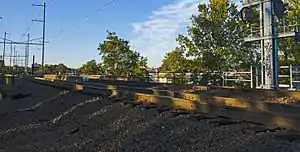Woodbridge train derailment
On February 6, 1951, a Pennsylvania Railroad train derailed crossing a temporary wooden trestle in Woodbridge, New Jersey, killing 85 people. It remains New Jersey's deadliest train wreck, the deadliest U.S. derailment since 1918, and the deadliest peacetime rail disaster in the United States.[1]
| Woodbridge train derailment | |
|---|---|
 Accident site in 2016 | |
| Details | |
| Date | February 6, 1951 5:43 pm |
| Location | Woodbridge, New Jersey |
| Country | United States |
| Line | North Jersey Coast Line |
| Operator | Pennsylvania Railroad |
| Incident type | Derailment at diversion |
| Cause | Excessive speed |
| Statistics | |
| Trains | 1 |
| Deaths | 85 |
| Injured | ~500 |
Description
Around 5 p.m. on Tuesday, February 6, 1951, Pennsylvania Railroad Train No. 733 left Exchange Place in Jersey City. An express train to Bay Head via the North Jersey Coast Line, No. 733 was crowded that day due to a labor strike on the nearby Jersey Central Railroad. It carried over 1,000 passengers[2] in 11 cars drawn by PRR K4 4-6-2 steam locomotive No. 2445.[3]
That afternoon, rail traffic through Woodbridge was being diverted onto a temporary wooden trestle and a shoofly near Fulton Street, allowing laborers building the New Jersey Turnpike to work on the main line. A notice had gone out to train engineers in late January: after 1:01 p.m. on February 6, they were to proceed through Woodbridge not at the normal 60 mph (97 km/h) but at 25 mph (40 km/h).[4]
Before Train No. 733 left Jersey City, its conductor reminded engineer Joseph Fitzsimmons about the speed restriction. Fitzsimmons failed to slow the train as it approached Woodbridge. About a mile before the town, the conductor, alarmed at the train's speed, tried to pull the emergency cord, but the crush of passengers made it impossible.[4]
The train was traveling faster than 50 mph (80 km/h) when it hit the curve approaching the trestle, according to a subsequent inquiry. At 5:43 p.m., the tracks shifted under the massive locomotive, and eight of the train's eleven passenger cars derailed. The first two cars fell on their sides. The third and fourth cars crashed into each other as they hurtled down a 26-foot-high (7.9 m) embankment. It was in these two cars that most of the 85 deaths occurred. The fifth and sixth cars were left hanging in mid-air over a street that glistened from rain. Some passengers may have jumped to their deaths, believing they would land in water. The accident occurred in a heavily populated area, so help soon arrived. Neighbors opened their houses and businesses to those in need. The critically injured were taken to nearby hospitals.[2][5]
Although Fitzsimmons claimed that he had been travelling at only 25 mph (40 km/h), the inquiry estimated that the train's speed was between 50 and 60 mph (80 and 97 km/h). The report concluded that the wreck was caused by "excessive speed on a curve of a temporary track". Fitzsimmons continued working for the railroad, but never operated a train again.[2]
Near the derailment site, the victims are memorialized by a pair of historical markers, installed by New Jersey Transit in 2002 and by Woodbridge Township in 2013.[6][7]
References
- "The Nation: Disaster at Woodbridge". The New York Times. February 11, 1951. Retrieved September 18, 2018.
- Margolin, Josh (January 25, 2001). "'I never saw anything like it... It was like a war scene'". The Star-Ledger. Archived from the original on July 25, 2008 – via Woodbridge Fire Department.
- Mittner, Gary (ed.). "Locomotive image K4 #2445". Angelfire.com. Retrieved February 5, 2014.
- Hayslett, Chandra M. (February 5, 2001). "1951 train wreck recalled in tears". Home News Tribune. Archived from the original on July 25, 2008 – via Woodbridge Fire Department.
- "Crowded Commuter Cars Plunge Off Rails at Temporary Road Overpass in Woodbridge". The New York Times. February 7, 1951. Retrieved September 18, 2018.
- "Great Woodbridge Train Wreck of 1951". Historical Marker Database. Retrieved November 28, 2020.
- "Fulton Street Train Wreck". Historical Marker Database. Retrieved November 28, 2020.
Further reading
- Bond, Gordon (2017). Man Failure: The Story of New Jersey's Deadliest Train Wreck. Garden State Legacy. ISBN 978-0692867983.
External links
- Dziobko, John (February 7, 1951). "Pennsylvania Railroad at Woodbridge, New Jersey". Color photo of the scene the day after the accident.
- Interstate Commerce Commission (April 19, 1951). "Accident at Woodbridge, N.J.". Report of the accident investigation.
- Malwitz, Rick (January 28, 2001). "'The Broker' train accident stirs emotions". Gannett New Jersey.
- Sesnowich, Mike H. (2009). "The Woodbridge Train Wreck". Includes dozens of documentary photos from the scene.